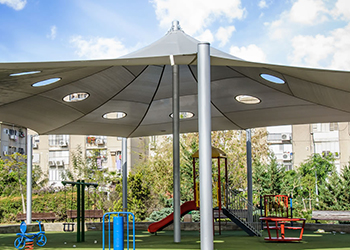A sun-safe strategy for educators is applying methods to increase shade such as providing structures or shade trees in high-use outdoor areas and relocating outdoor activities to shaded areas.
Nearly 5 million people are treated for skin cancer each year in the United States. Skin cancer can be serious, expensive, and sometimes even deadly. One bad sunburn in childhood doubles the risk of skin cancer later in life. Fortunately, most skin cancers can be prevented.
 Broad spectrum sunscreen with an SPF of 15 or higher is important, but it shouldn’t be your only defense against the sun. For the best protection, use shade, clothing, a hat with a wide brim, and sunglasses, as well as sunscreen.
Broad spectrum sunscreen with an SPF of 15 or higher is important, but it shouldn’t be your only defense against the sun. For the best protection, use shade, clothing, a hat with a wide brim, and sunglasses, as well as sunscreen.
- Ultraviolet (UV) rays—from the sun or from artificial sources like tanning beds—are known to cause skin cancer.
- Damage from exposure to UV rays builds up over time, so sun protection should start at an early age.
- Keep students sun safe, and teach them to avoid indoor tanning.
BE AWARE OF RISKS
- Most children and teens spend a lot of time in school settings.
- Students are typically at school during midday hours when the UV rays from the sun are strongest. Recess and other outdoor activities during midday can put students at risk if they aren’t protected.
- Students who learn to use sun protection and avoid indoor tanning during the school years are reducing their chances of a skin cancer diagnosis later in life.
USE THESE SUN-SAFE STRATEGIES
INCREASE SHADE
- Provide structures or shade trees in high-use outdoor areas.
- Relocate outdoor activities to shaded areas.
- Plan for shade when developing or renovating school buildings, playgrounds, or athletic fields.
- Use CDC’s Shade Planning for America’s Schools pdf icon[PDF-975KB] to guide your shade-planning efforts. This resource provides guidance and tools for increasing the availability and use of shade on school grounds.
ENCOURAGE SUN-SAFE BEHAVIORS
- Allow or encourage students to wear hats, sunglasses, and sunscreen while outdoors. The Sun Safe Colorado website has tips on how to write a school policy on sun safety.
- When possible, avoid scheduling outdoor activities during midday when the sun is strongest. Remember that sunburns and skin damage can occur even on cloudy or overcast days.
- Include sun protection in student athletic activities to protect athletes, coaches, and fans. (See the Steps that High Schools, Colleges, and Universities Can Take section for specific ideas.)
- Provide routine breaks during outdoor activities to allow students to reapply sunscreen and get water.
USE PROVEN EDUCATION PROGRAMS
- Use proven skin cancer prevention interventions and education programs in child care centers and classrooms. Visit the National Cancer Institute’s RTIPs website for information about sun-safety programs for schools.
- Use everyday activities like recess, physical education classes, and outdoor extracurricular programs to reinforce and model sun protection messages.
DISCOURAGE INDOOR AND OUTDOOR TANNING
- When you talk with students about sun safety, talk about indoor and outdoor tanning. Emphasize the importance of embracing your natural skin color.
- Educate students about the risks of intense UV rays from indoor tanning.
- Don’t wait until the teen years to talk to your students about indoor tanning. Children may be more receptive than teens, so start the conversation early, before they start tanning.
INDOOR TANNING
Indoor tanning exposes users to intense UV rays to tan the skin for cosmetic reasons. The U.S. Food and Drug Administration states that indoor tanning should not be used by anyone younger than age 18. Many states restrict the use of indoor tanning by minors. Despite the risks, indoor tanning is common among adolescents and young adults. As of 2017, about 10% of non-Hispanic white high school girls were indoor tanning. Indoor tanning often begins during adolescence and continues into adulthood.DRESS THE PART
Some school dress codes and other policies may unintentionally prevent students from protecting themselves from the sun. For example, some schools don’t allow students to wear hats or carry sunscreen. Educators should consider revising school policies to help students protect their skin when outside. Wide-brimmed hats, long sleeves, long pants, and sunglasses provide the most protection.SKIN CANCER PREVENTION IN ACTION: BANDELIER ELEMENTARY SCHOOL
Albuquerque, New Mexico (NM) is a sunny city with high levels of UV rays. At Bandelier Elementary School, parents and staff take steps to protect their students from the strong Albuquerque sun and skin cancer later in life. In 2003, Bandelier parent Erika Harding proposed that the school’s parent-teacher association (PTA) set up a Sun & Shade Committee. Since then, the Bandelier PTA Sun & Shade Committee has worked with the NM Department of Health RAYS (Raising Awareness in Youth About Sun Safety) Project to give wide-brimmed hats to all kindergarteners, teach sun safe behavior to kids and the community, and make shade a component of all playground improvements. Harding said she proposed the project because “we want our kids to be healthy, active, and sun safe too.” Principal Glenda Armstrong added that she is proud of the sunshades over the school’s playground. “The Sun & Shade Committee made the case for increasing shade for our students and our legislators listened, providing funding for playground shade structures.” If you’d like to make your school campus sun safe, look for ideas in CDC’s Shade Planning for America’s Schools. pdf icon[PDF-975KB]STEPS THAT HIGH SCHOOLS, COLLEGES, AND UNIVERSITIES CAN TAKE PROMOTE SUN PROTECTION THROUGH ATHLETICS
- Provide shade for players and fans through covered benches, bleachers, and fields.
- Post signs in locker rooms, bathrooms, and stadiums to remind students to use sun protection.
- Promote sun safety as part of school spirit. Sell wide-brimmed hats, sunglasses, sunscreen, and umbrellas to fans.
- Include wide-brimmed hats and sunglasses as part of team uniforms and equipment. Baseball caps, for example, protect the face but leave the ears and neck exposed. Some sun protection equipment may not be appropriate during play, but could be used during warm-ups or practice or on the sidelines.
DISCOURAGE INDOOR AND OUTDOOR TANNING
- Encourage student-led initiatives before special events like homecoming, prom, or spring break to raise awareness about the risks of indoor and outdoor tanning and encourage students to embrace their natural skin color.
- Discourage the presence or use of indoor tanning devices on campuses, in dorms, or in off-campus housing for students.
- Reconsider on-campus promotion of indoor tanning and the use of university debit cards for indoor tanning services.
CHOOSE SUN-SAFETY STRATEGIES THAT WORK
 Broad spectrum sunscreen with an SPF of 15 or higher is important, but it shouldn’t be your only defense against the sun. For the best protection, use shade, clothing, a hat with a wide brim, and sunglasses, as well as sunscreen.
Broad spectrum sunscreen with an SPF of 15 or higher is important, but it shouldn’t be your only defense against the sun. For the best protection, use shade, clothing, a hat with a wide brim, and sunglasses, as well as sunscreen. 

